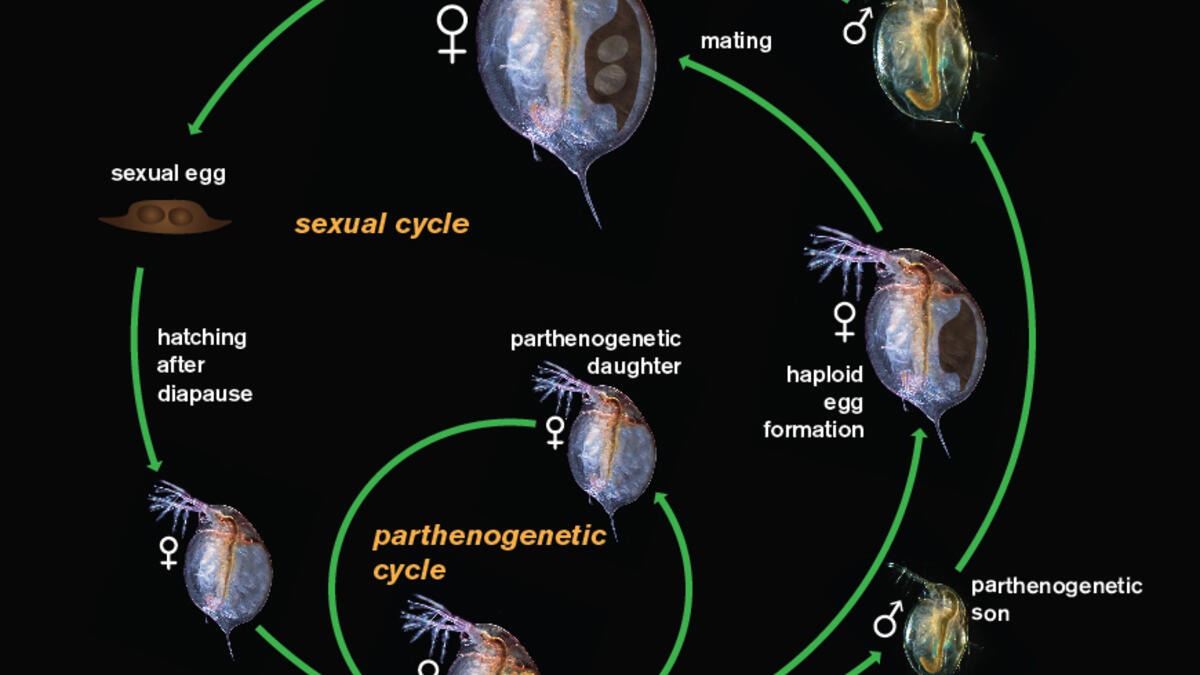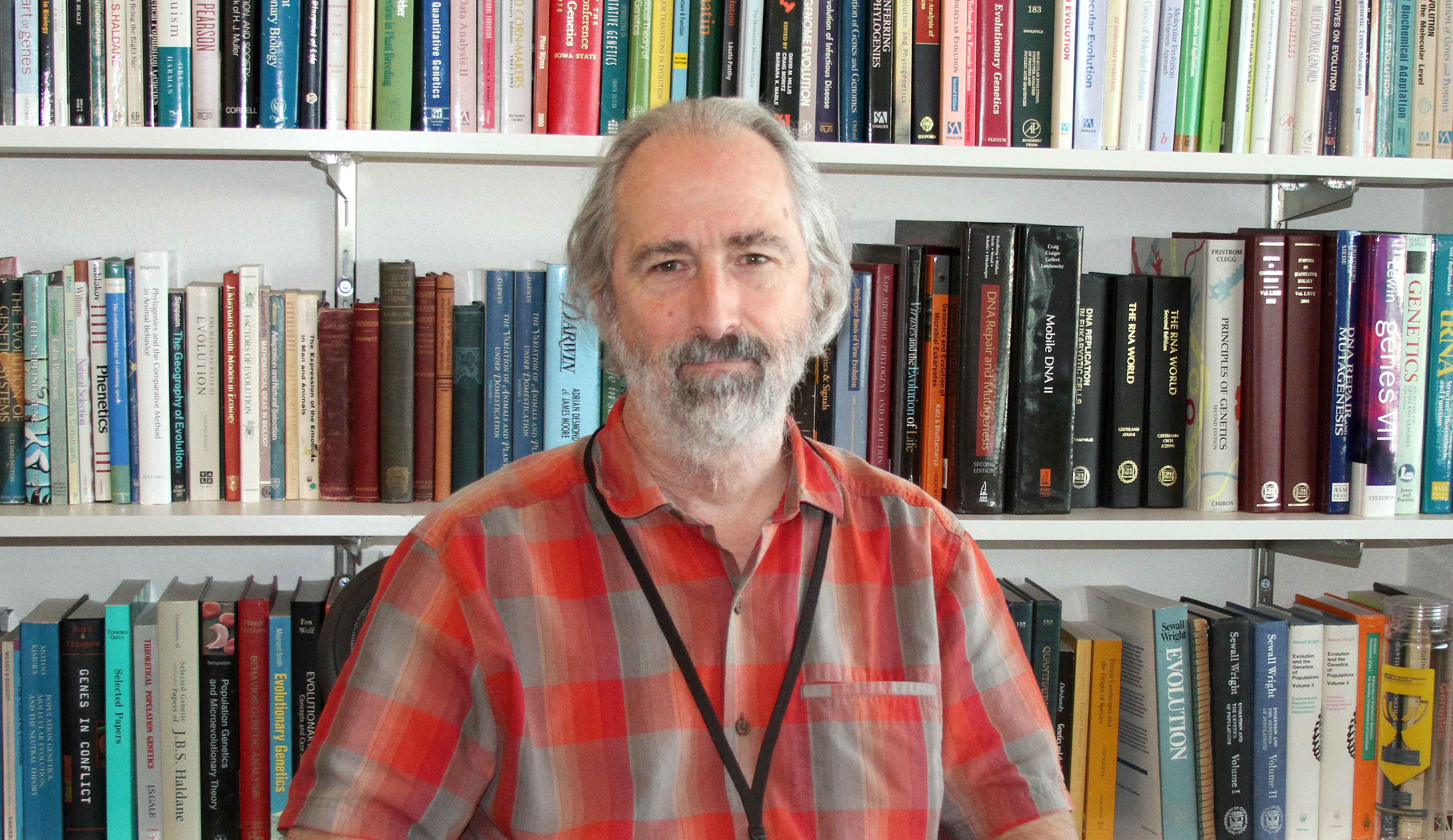Sex, lies and crustaceans: New study highlights peculiar reproductive strategies of Daphnia

Daphnia are microcrustaceans that inhabit ponds and lakes around the world. This graphic shows the unusual reproductive strategy used by the organism. In this system, known as cyclic parthenogenesis, Daphnia can alternate between sexual and parthenogenetic (asexual) reproduction. Graphic by Shireen Dooling
Flourishing in spectacular numbers in lakes and ponds around the world, tiny creatures known as Daphnia play an essential role in freshwater ecology. Daphnia, a type of planktonic crustacean, are the primary consumers of algae and are an important food source for fish and other aquatic life.
Daphnia are ubiquitous in freshwater sources, but their mode of reproduction, known as cyclic parthenogenesis — which involves alternating phases of sexual and asexual reproduction — is an evolutionary puzzle. A further mystery surrounding Daphnia is that in some populations, up to 50% of females do not produce male offspring.
Now, Arizona State University's Michael Lynch and his colleagues, including lead author Zhiqiang Ye, believe they have identified a variation in a single gene (unique to Daphnia) that accounts for the non-male-producing (NMP) trait. Isolation of this NMP dominant allele sheds new light on the behavior of this important model organism as well as broader genetic mechanisms of male offspring production. Eventually, new insights into such mechanisms could spur innovations in fertility treatment or, alternately, in pest management.
“What we discovered is that there are members of some Daphnia populations that are incapable of producing boys,” Lynch said. “We have a chemical that we use called methyl farnesoate that we squirt in the water to induce male production and they don’t even respond to that. So there are two flavors of individual in the population — one that produces daughters and sons and one that can only produce daughters.”
Lynch directs the Biodesign Center for Mechanisms of Evolution and is a professor at ASU’s School of Life Sciences. The group’s research on Daphnia appears in the current issue of the journal PNAS.
Michael Lynch directs the Biodesign Center for Mechanisms of Evolution and is a professor at ASU's School of Life Sciences. He is a member of the US National Academy of Sciences, and a fellow of the American Academy of Arts and Sciences.
Beneath the surface
Daphnia, while just visible to the naked eye, are best observed under the microscope, where their translucent forms allow a clear view of internal structure. A heart that beats at a brisk 300 pulses per minute can clearly be seen along with the creature’s five pairs of legs, which Daphnia use to sweep algae and organic detritus into their digestive tract. (Daphnia’s cleanly visible structure coupled with their essential role in freshwater ecosystems have made them a vital organism for the study of ecology and physiology for over 100 years.)
Daphnia measure roughly 1-3 millimeters in length and feature prominent compound eyes sensitive to sunlight striking pond and lake surfaces, a durable carapace, antennae and a pair of hair-like abdominal structures known as setae.
Also visible in Daphnia is a brood chamber, where offspring resulting from sexual and asexual or parthenogenetic reproduction develop before birth. The movements of immature young can often be seen in the brood chamber.
Daphnia are prolific egg producers, and it is estimated their numbers would quickly overpopulate a pond, were they not perpetually eaten by other aquatic life. Their rapid, abbreviated movements in the water are somewhat flea-like, and they are often referred to as water fleas, though they are microcrustaceans, not insects.
While there are over 200 species in the Daphnia genus, the most common (and the subject of the current study) are Daphnia pulex. (Precise taxonomy of Daphnia remains controversial, partly due to hybridization, phenotypic plasticity and other factors.)
Innovations in sex
Daphnia use a combined strategy of asexual and sexual reproduction during their life cycle. During most of the growth season, females reproduce asexually, producing diploid eggs (bearing two sets of chromosomes and producing genetically identical offspring). These eggs typically hatch two to three days after being transferred to the Daphnia’s brood pouch.
Late in the season, as environmental conditions change, the reproductive lifestyle of Daphnia shifts. Females begin producing males and what are known as resting eggs (or winter eggs). These are highly durable and capable of surviving intact — through extreme cold, drought or periods of scarce nutrients — for years or even decades, until environmental conditions become favorable for their hatching and development. Resting eggs are fertilized internally by male Daphnia before being deposited in the brood capsule.
Searching for clues
The new study examines a subset of clones of Daphnia pulex with a peculiar attribute: They only produce female offspring. Careful examination of these non-male-producing Daphnia (NMP) identified some 3,500 specific genomic markers found only in the NMP individuals. The researchers successively narrowed the field of candidate markers, comparing them with other NMP populations and looking for overlap, finally identifying just five protein-coding variants exclusively associated with the NMP Daphnia, all of which belong to a single gene.
Although some Daphnia populations have no members carrying the NMP variant, Lynch and his colleagues got lucky on their first try, sequencing 100 individuals, roughly half of which were non-male-producers. Further, the NMP markers were all found in a confined region of the Daphnia genome, near the tip of Chromosome 1. The variant that appears to be responsible for the NMP trait occurs on a gene labelled 8960, about which many questions remain. The gene is not present in other arthropods and appears unique to Daphnia.
“We have a huge Daphnia genome project,” Lynch said. “We’ve sequenced about 2,000 Daphnia genomes, and we’re continuing to do so. It’s one of the biggest genome projects — maybe the biggest, except for the human genome project.”
Zhiqiang Ye, a postdoc in Lynch’s lab and lead author of the new study, carried out much of the laboratory work. He examined gene expression in the male-producing and non-male-producing alleles and demonstrated that the NMP allele was largely nonresponsive to methyl farnesoate, a critical hormone responsible for conferring male traits in Daphnia offspring.
Reproductive quandary
In evolutionary terms, the rationale for creating NMP Daphnia remains speculative. Intriguingly, the NMP trait appears to have originally been imported from a sister species of D. pulex, known as D. pulicaria. The NMP allele may act to limit the deleterious effects of too much inbreeding in Daphnia populations or simply help maintain an equilibrium of male production. The study, Lynch points out, may offer new clues concerning the origins and lifeways of obligate asexual organisms (i.e., those that rely exclusively on asexual reproduction, a major conundrum in evolutionary biology).
The NMP phenotype bears similarity to a reproductive strategy found in so-called gynodioecious plants. “In a gynodioecious system, you have individuals who produce both male and female gametes and some that are only female,” Lynch said. “In a superficial sense, it’s very much like the Daphnia system.”
In future research, Lynch and colleagues will apply the CRISPR-Cas9 gene editing methodology to the study of Daphnia, opening a new avenue of research into the genetics and genomics of this model organism. One proposed experiment will use the technique to knock out the gene responsible for male production or edit the NMP allele, to definitively establish gene 8960 as the culprit for the NMP trait in Daphnia.
More Science and technology

ASU students win big at homeland security design challenge
By Cynthia GerberArizona State University students took home five prizes — including two first-place victories — from this year’s…

Swarm science: Oral bacteria move in waves to spread and survive
Swarming behaviors appear everywhere in nature — from schools of fish darting in synchrony to locusts sweeping across landscapes…

Stuck at the airport and we love it #not
Airports don’t bring out the best in people.Ten years ago, Ashwin Rajadesingan was traveling and had that thought. Today, he is…


